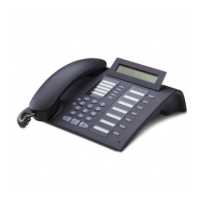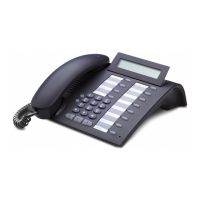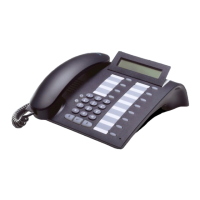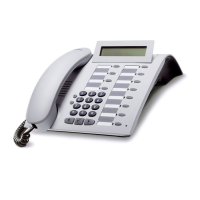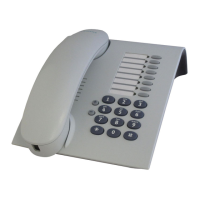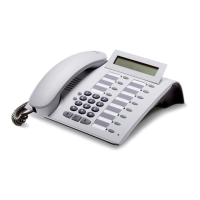Do you have a question about the Siemens OptiPoint 410 and is the answer not in the manual?
General safety advice for telephone users to prevent harm or damage.
Guidelines to prevent damage to the telephone unit.
Recommended placement and environmental conditions for optimal operation.
Key information and disclaimers regarding product use and performance.
Explanation of conformity marks and disposal symbols.
Introduction to the manual's purpose, structure, and scope.
Specifies the telephone's designed purpose and limitations.
Guidance on locating product identification details on the unit.
Explanation of potential echo issues and their causes during calls.
Information on obtaining technical support for telephone issues.
Explanation of important notes and symbols used throughout the manual.
Detailed explanation of manual symbols and their operational meanings.
General description of the IP telephone and its core capabilities.
Lists the key features and functionalities of the telephone.
Outlines the different types of telephone configurations available.
Diagram illustrating the physical layout and components of the phone.
Table comparing specifications across different phone models.
Explains the telephone's display and the function of dialog keys.
Details the functionality and usage of the telephone's keypad.
Information on how to use and program function keys.
Explains the function and operation of the control keys.
Covers basic dialing and enhanced calling features.
Discusses features specific to multiline telephone configurations.
Describes how to select and activate functions using menu options.
Details how to handle incoming calls.
Step-by-step guide to answer calls using the handset.
Instructions for answering calls using speakerphone mode.
Procedures for terminating an active call.
How to switch to speakerphone mode during a call.
Guide to switching from speakerphone back to handset.
How to enable others to listen to the call via speakerphone.
Steps to reject an incoming call.
Information on handling a second incoming call.
Steps to accept a call that arrives while another is active.
How to decline a waiting call.
Procedures for answering calls on different lines.
Instructions on placing an active call on hold.
Navigating menus to manage call functions.
How to use line keys for call management on multiline phones.
Methods for transferring calls to other parties.
Guide to transferring calls after consulting with the recipient.
How to dial a number after seizing a line on multiline phones.
Steps to redial the last dialed number.
How to dial a number before seizing a line.
Operating devices using DTMF tones during a call.
List of calls that were not answered.
List of numbers that have been dialed.
List of incoming calls that were answered.
List of calls that were forwarded.
Instructions on how to view call log entries.
Procedures for making a call from the log.
How to remove entries from the call log.
Method to clear the entire call log.
Navigating through call log entries.
Using the dedicated key for missed calls.
Functionality of the redial key for last dialed numbers.
Steps to initiate a consultation call with another party.
Procedures to end a consultation hold.
How to switch between parties during a consultation.
Steps to set up a conference call.
Methods for terminating an active conference call.
Using the menu to add parties to a conference.
Adding parties to a conference via hanging up.
Adding more participants to a conference.
How to terminate a centralized conference.
Instructions to begin recording a call.
Steps to stop an ongoing call recording.
Using pre-programmed keys for quick dialing.
Setting an automatic delay for dialing numbers.
How to program and use abbreviated dialing numbers.
Storing and calling numbers using the notebook feature.
Utilizing repertory dialing keys for call sequences.
Steps to access and listen to voice messages.
How to view details of recorded messages.
Enabling the DND feature to silence incoming calls.
Assigning a key for quick DND activation/deactivation.
How to park an active call on a server for later pickup.
Step-by-step process for parking a call.
Instructions on how to retrieve parked calls.
Detailed steps to pick up a parked call.
Information on joining and using pickup groups.
Configuring automatic dialing for specific lines.
Explains lines, line keys, and their associated LEDs.
Describes different types of telephone lines (Private, Shared, Direct).
Details line usage and types like Prime, Secondary, Phantom.
Functionality of lines in multiline telephones.
How lines are seized and managed.
Handling incoming calls with ring or wait tones.
Methods for initiating outgoing calls.
Options available when answering a call on a line.
How to manually put a call on hold.
Handling incoming calls while already on a call.
Managing incoming calls during dialing.
Explains the extended functions of the Cancel key.
Overview of call forwarding features.
Setting up call forwarding when there's no reply.
Forwarding all incoming calls to another destination.
Temporarily hiding caller ID for the next call.
Re-enabling caller ID after temporary suppression.
How to use speed dialing codes for frequently called numbers.
Redialing the last dialed or incoming number.
Generating a call trace for received calls.
Retrieving calls ringing at other extensions.
Guide to entering the telephone's setup menu.
Viewing current telephone status and settings.
Customizing various telephone settings.
Adapting settings for country-specific characteristics.
Setting the language for operator prompts and menus.
Adjusting date, time, and display modes.
Detailed steps for setting date and time.
Activating/deactivating the call duration display.
Enabling call waiting functionality.
Activating/deactivating call transfer feature.
Enabling/disabling the feature to join calls.
Adjusting the display contrast level.
Setting input mode for dialing numbers.
Defining caller information display for incoming calls.
Automating clock adjustments for daylight saving.
Setting the delay before automatic dialing.
Setting reminders for calls on hold.
Activating/deactivating music for callers on hold.
Permitting or prohibiting the DND feature.
Activating/deactivating the message waiting indicator.
Activating/deactivating hold ringback reminders.
Enabling/disabling local three-party conferences.
Activating/deactivating auto answer for CTI applications.
Specifying audible beeps for auto-answered calls.
Activating/deactivating call reconnect options.
Audible beeps for automatically reconnected calls.
Configuring system message display in idle mode.
Setting the period of inactivity before reverting to idle state.
Specifying where call view appears after restart.
Setting the language for an external USB keyboard.
Configuring line keys for multiline telephones.
Controlling line visibility in the multiline overview.
Setting the position of lines in the multiline overview.
Displaying line status in call info boxes.
Choosing between icons and text for display messages.
Overview of call parking and pickup functions.
Enabling or disabling call park functionality.
Configuring on-hook dialing settings (Context/Hot-Keypad).
Setting up callback requests when parties are busy.
Controlling missed call notifications.
Automatically rejecting incoming calls while dialing.
Allowing hang-up during call transfer before answer.
Activating/deactivating call recording functionality.
Programming up to 12 abbreviated dialing entries.
Setting or changing the user password for security.
Locking the phone to prevent unauthorized access.
Options for clearing abbreviated dialing numbers or resetting defaults.
Restoring phone settings to factory defaults.
Step-by-step guide to assign Mute to a function key.
How to assign Repertory Dialing to a function key.
Assigning functions to the first level of function keys.
Assigning numbers/names to function keys.
Assigning functions to the second level of function keys.
How to call programmed functions based on phone status.
Adjusting loudspeaker volume in idle mode and during calls.
Setting ringer volume for single and multiline phones.
Setting ringer tone sequence and melody.
Resetting ringer settings to factory defaults.
Adjusting the volume of the handset.
Adjusting headset volume.
Adapting room acoustics for handsfree talking.
Enabling or disabling key click feedback.
Adjusting volume for rollover calls.
Procedure for restarting the telephone.
How the display appears when starting call control.
Quickly switching between telephone and display module views.
Navigating through available applications on the display.
How incoming calls are displayed in idle mode.
Steps to answer an incoming call.
Saving caller information to the contacts.
How to refuse an incoming call.
Turning the ringer on or off.
Information on handling a second incoming call.
How to accept a second call while on another.
How to refuse a waiting call.
Steps to put an active call on hold.
Methods to transfer a call to another party.
Procedures to end an active call.
Accessing the list of missed calls.
Displaying icons for received voice messages.
How to dial a number off-hook.
How to dial a number by lifting the handset.
Dialing numbers by speaking contact names.
How to dial a number without lifting the handset.
Methods to end a call using icons or handset.
How to call contacts from the phone book.
Using programmed repertory dialing keys.
Entering dial control functions in repertory dialing sequences.
Initiating consultation while on an active call.
Initiating consultation while on an active call.
Transferring a held call to a second party.
Connecting two parties to each other during consultation.
Switching between parties for a second incoming call.
Switching between parties for a second incoming call.
Switching between parties in a consultation call.
Creating a conference call from an existing second call.
Creating a conference call from an existing second call.
Initiating a conference from a consultation call.
Placing an active conference call on hold.
Methods for terminating a conference call.
Steps to start a centralized conference call.
Steps to start a centralized conference call.
Adding another participant to a conference.
How to terminate a centralized conference.
Using an option to redial the last number.
List of numbers dialed, sorted by date and time.
List of numbers dialed, sorted by date and time.
Accessing the list of unanswered calls.
Viewing details of call log entries.
List of answered incoming calls.
Prerequisite: Do Not Disturb must be configured.
Process of parking an active call on a server.
Process of parking an active call on a server.
Instructions for retrieving parked calls.
What happens when the phone loses connection to the server.
How call view is displayed for multiline phones.
How call view is displayed for multiline phones.
How preferred lines are selected for calls.
Display showing the status of multiple lines.
Scrolling through lines when more than seven are configured.
Display of incoming calls with ring/wait tones.
How to view line details and available call options.
Connecting with a caller via the Line Box.
How to initiate calls by seizing a line.
Dialing a number by seizing a line and then dialing.
Dialing a number without lifting the handset.
Actions possible when the prime line is busy.
Options available after answering a call.
Putting a call on hold manually.
Showing line status and information in Call Control.
Showing line status and information in Call Control.
How to answer calls on different lines.
How line information boxes display call details.
Navigating to the line overview screen.
Showing ringing line status during an active call.
Showing ringing line status during an active call.
Displaying information for a line on hold.
Handling incoming ring/wait tones during dialing.
Switching between numeric and alphanumeric input modes.
Switching between numeric and alphanumeric input modes.
Toggling between overwrite and insert text input modes.
Activating overwrite mode for text input.
Using stylus or keys to select display elements.
Using stylus or keys to select display elements.
How to edit fields using control keys.
Mapping telephone control keys to display module functions.
Accessing the setup menu via the display module.
Overview of the web server and its interface.
Instructions to access the web interface via a browser.
Instructions to access the web interface via a browser.
Accessing the user area of the web interface.
Procedure to change the user password via web interface.
Procedure to change the user password via web interface.
Assigning functions to phone keys via web interface.
Assigning functions to phone keys via web interface.
Assigning Loudspeaker function to a key.
Assigning Selected Dialing to a key.
Assigning Phone Lock function to a key.
Assigning Repertory Dialing to a key.
Configuring country-specific settings via web interface.
Setting the language via the web interface.
Adjusting audio settings (volume, melody) via web interface.
Configuring call-related parameters like timers and dialing mode.
Logging off as a mobile user.
Control functions for repertory dialing sequences.
Control functions for repertory dialing sequences.
Setting time for CFNR forwarding.
Selecting country for specific telephone settings.
Setting handset volume via web interface.
Configuring idle dialing mode via web interface.
Setting key click volume via web interface.
Specifying name for automatic key labeling.
Selecting language settings via web interface.
Setting loudspeaker volume via web interface.
Setting ringer melody via web interface.
Logging off a mobility user.
Settings for phone lock when the telephone is locked.
Control functions for repertory dialing sequence.
Setting phone number for direct inward dialing.
Setting ringer volume via web interface.
Setting rollover volume via web interface.
Choosing functions for first and second level keys.
Assigning function key for alternating between callers.
Assigning function key for call transfer.
Assigning function key for call connection.
Assigning function key for deflecting calls.
Assigning function key to evoke setup menu.
Assigning function key for room acoustics.
Assigning function key for room acoustics.
Assigning function key for second level keys.
Assigning function key for notebook function.
Assigning function key for checking status.
Assigning function key for locking phone.
Assigning function key to log on as mobile user.
Assigning function key for initiating conference.
Assigning function key for headset activation.
Assigning function key for DND.
Assigning function key for pickup groups.
Assigning repertory dial function to key.
Assigning function key for special functions.
Assigning function key to swap displays.
Assigning function key for parking calls.
Assigning function key for accepting parked calls.
Assigning function key for call recording.
Assigning function key for ending calls.
Setting ringer sequence for incoming calls.
Password input for web interface user area.
Using the keypad to enter text, numerals, and special characters.
Detailed table of characters and their keypad input.
Using keys for navigation and editing text.
Overview of messages displayed in idle mode with priority.
Hierarchical listing of telephone menu options.
Hierarchical listing of telephone menu options.
Default settings for menu options.
Detailed breakdown of menu options and defaults.
Further detailed breakdown of menu options and defaults.
Options for dialing numbers and names.
Options for dialing numbers and names.
Actions related to call connection states.
Actions and next steps for consultation calls.
Actions for handling incoming calls.
Actions for using group pickup and ignore features.
Explanations of status messages displayed on the phone.
Explanations of status messages displayed on the phone.
Descriptions of LED status indications for line keys.
Explanations and handling of error messages.
Methods for labeling telephone keys by hand or via internet tool.
Methods for labeling telephone keys by hand or via internet tool.
| Number of Programmable Keys | 8 |
|---|---|
| Speakerphone | Yes |
| Headset Connection | Yes |
| Color | Black |
| Lines | 2 |
| Networking | Ethernet |
| Type | Digital phone |
| Display | LCD |
| Keypad | Numeric |
| Weight | 1.2 kg |
